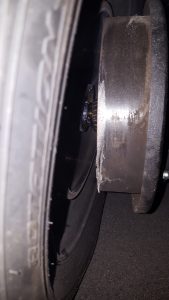Bus Front Bearing Failure
This weekend during a test drive of added soundproofing, the front left started getting noisy and shortly later there was a pop and a slight swerve. I safely got it to a parking lot, but the front wheel bearings were metal-on-metal at that point, and the wheel had shifted outwards so it wasn’t possible to drive any further.

With the wheel shifted out I didn’t want to risk further damage when loading on a tow truck, so Christina came to pick me up and we returned with a trunk full of tools and spare bearing from home to replace the bearing on-the-spot. This would have been a ~30min job except that the spindle nut and inner race of the outer bearing had lightly welded themselves to the spindle. I returned with a dremel (and inverter to power it) – the spindle nut was removed, but removing the bearing race was not possible. I found a big metal spacer that served the purpose of keeping the wheel retained on the spindle, though it did not work as a bearing and wasn’t driveable more than a few hundred feet.
With the spacer in place it was safely towed back. The next morning with better light and bigger tools I was able to get the bearing race off of the spindle. The bearing was even available locally and I got it all back together quickly. Special attention was paid to the bearing end-play, this was set to the correct spec with a dial indicator and the bearing thoroughly greased. This was then repeated on the other side.
The front wheel bearings were perhaps the only area that I had not yet gone through since getting the bus; so the failure isn’t necessarily surprising. Both sides had minimal grease and light rust pitting which, along with the bus’s new faster speeds, contributed to the overheating and failure.
Rear Lowered
In the video it’s readily apparent that the back is higher than the front. This is because I had flipped the front spindles but not yet adjusted the rear suspension. Tonight and last night I fixed this by re-indexing the torsion bar spring plates one notch lower. I didn’t get any pictures but it is much better looking now; it’s within a degree or so of being level. The rear is still very slightly higher than the front; this should be corrected by the weight of the parts that are yet to be installed (windows, interior). Even if this is not the case I prefer this to having the front slightly higher, which looks odd; nearly all modern cars are biased towards having the rear higher when unloaded.








